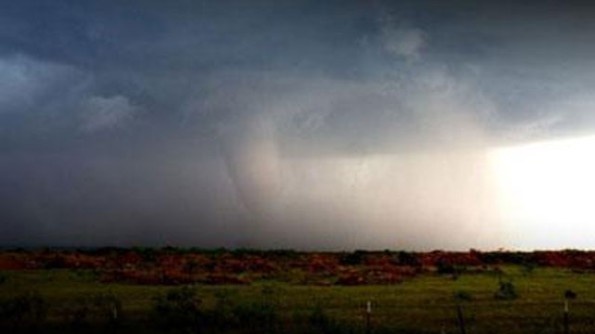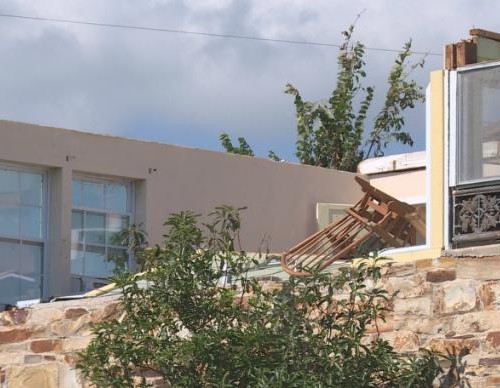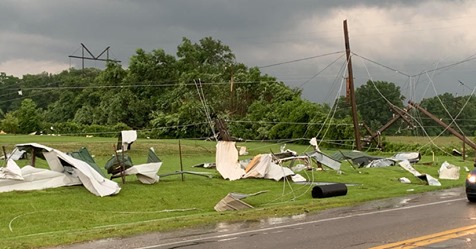Tornadoes in the South tend to stay on the ground longer, and move faster. Many of the storms occur overnight, when most people are sleeping and unaware that a tornado is approaching. Unlike the Plains, where you can see the tornado coming for miles, the South has much more rugged terrain, making it difficult to spot a tornado coming. Because of this, this region has been difficult to study — until now.
The CNN Severe Weather Team has the unique opportunity to go along with scientists from around the world as they study tornadoes in Dixie Alley. It’s called VORTEX-SE. The VORTEX project began in 1994, with the objective of explaining how tornadoes form. The two-year field project resulted in groundbreaking data collection that has been critical in educating and forecasting severe weather. Both VORTEX 1 and VORTEX 2 were focused in the Plains (Tornado Alley).
You may remember the movie “Twister” from the mid-’90s. The movie was based on the VORTEX project. After learning so much about tornado formation in the Plains, VORTEX-SE will focus on Dixie Alley. Tornado formation in Dixie Alley is very different from the Plains, so scientists want to study this area to find out what triggers these monster storms and makes them so deadly.
Despite these dangers, scientists are attempting to study these Southern tornadoes in the VORTEX-SE storm-chasing field campaign, trying to learn what makes these tornadoes unique and why “the number of killer tornadoes in this region is disproportionately large” compared to the rest of the country. Follow along below as we join the chase and learn more about these monster storms.
The CNN Severe Weather Team will be joining the VORTEX mission on Thursday.
What is Dixie Alley?
Dixie Alley is the nickname given to an area in the Southeast United States that’s particularly vulnerable to strong tornadoes. This area includes portions of East Texas, Louisiana, Arkansas, Tennessee, Mississippi, Alabama and Georgia. Even though there are fewer tornadoes in Dixie Alley than in Tornado Alley, there have been more deaths in Dixie Alley than any other part of the country.
How do Dixie Alley storms differ from Tornado Alley storms?
The tornado tracks in Dixie Alley tend to be longer and move much faster. Many times the storms occur at night while people are sleeping. Also, a lot of the tornadoes in the Southeast are rain-wrapped, making them difficult to see. The hilly terrain with dense trees is very different from Tornado Alley, which is very flat and allows you to see the tornado coming for miles. Many times in the Southeast, you won’t see a tornado until it’s extremely close.
Which state experiences the most tornado deaths?
Mississippi, Alabama and Tennessee see the most tornado deaths per square kilometer and more killer tornadoes per square kilometer than anywhere else in the country. Mississippi averages 30 tornadoes per year and averages eight deaths per year. It also experiences the most tornadoes during the month of April. There were more than 100 tornadoes in the state in 2005, 2008 and 2011. While there may not be as many tornadoes by number in Dixie Alley as there are in Tornado Alley, there are more tornado-related deaths in Dixie Alley than anywhere in the United States.
Why are there more deaths in Dixie Alley than the rest of the country?
This area is more densely populated than Tornado Alley. There are more trees in the Southeast and the terrain is much more hilly, so you can’t see the tornado coming. In the South, there are more mobile homes, so tornadoes don’t have to be as strong to cause deaths. Many of these storms happen at night, while people are sleeping. Arkansas, Tennessee, Mississippi and Alabama all have 50% or more of their tornado deaths at night. In Tennessee, 73% of the tornado deaths occur at night. Many tornadoes that occur in this area are “rain-wrapped,” so they are less visible to the naked eye.
Most people in the Southeast don’t have a basement or underground shelter. This makes them more vulnerable to strong tornadoes.
What time of year is Dixie Alley most vulnerable to strong storms?
Dixie Alley doesn’t have one distinct season, like Tornado Alley. In Dixie Alley, three of the four seasons are prime for tornadoes. (Fall, winter, spring)
What does VORTEX stand for?
Verification of the Origins of Rotation in Tornadoes Experiment
Why do tornadoes in the Southeast move faster than tornadoes in the Great Plains?
Many storms in Dixie Alley develop in the spring and fall, and are pushed by a stronger jet stream, which results in faster-moving storms. It’s not uncommon for a tornado in the Southeast to travel faster than 50 mph. This puts more pressure on forecasters to get a tornado warning out in enough time for the public to react.
Why do tornadoes occur at night more than they do in the Great Plains?
Tornado season extends into the winter months in the Southeast, so the days are shorter and darker hours occur earlier in the day. This means there are more hours of darkness, when people are most vulnerable. Tennessee leads the country in percentage of nocturnal tornadoes, with 45.8%. The top five states for nocturnal tornadoes are in the Southeast.
The most dangerous time for a tornado is between midnight and sunrise. You are 2.5 times more likely to be killed during this period by a tornado than during daylight. The reason is because many people are asleep and unable to get to their safe place. Tornado sirens are meant for people outdoors, so those inside sleeping can’t hear them. This is why a NOAA weather radio is a must-have during severe weather. It will wake you if severe weather is close.
Does topography affect tornadoes? Can tornadoes follow the path of mountains and valleys?
Tornadoes are not diverted by any structure or terrain. A tornado will go where a tornado wants to go. Tornadoes have traveled from land to water and water to land. They have crossed very strong sturdy city buildings. And they have even been reported in the mountains above 10,000 feet. It is true that mountains see fewer tornadoes because they typically have cooler, more stable air. In July 1987, there was an F4 tornado at 10,000 feet in Teton National Forest in Wyoming. There was a tornado in July of 2012 near Mount Evans, Colorado, at nearly 12,000 feet.




